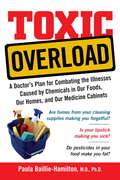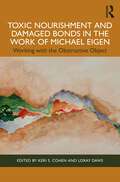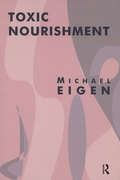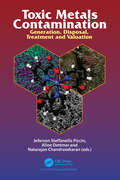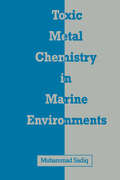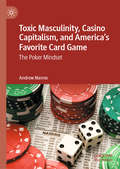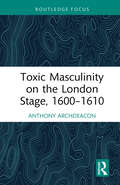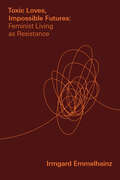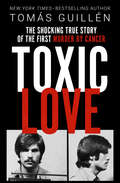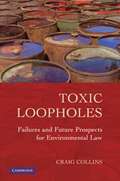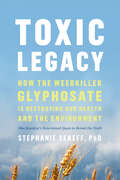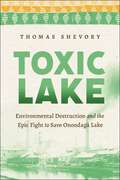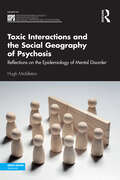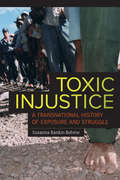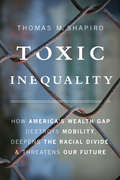- Table View
- List View
Toxic Overload: A Doctor's Plan for Combating the Illnesses Caused by Chemicals in Our Foods, Our Homes, and Our Medicine Cabinets
by Paula Baillie-HamiltonAre fumes from your cleaning supplies making you forgetful? Is your lipstick making you sick? Do pesticides in your food make you fat?<P> "Whether you currently have an illness that you wish to treat, are looking to optimize your existing health, or simply want to lower your changes of becoming ill in the future, this book is designed to help you achieve your health goals." --from the introduction.
Toxic Organizational Cultures and Leadership: How to Build and Sustain a Healthy Workplace
by Susan HetrickToxic organizational cultures and leadership have led to major reputational failures, with the greatest impact felt by the people who dedicate their careers to working for these organizations. And yet organizations do not become toxic overnight. They do not consciously set out to break rules and regulations, nor do they actively seek wrongdoing. This book defines toxic culture, explains how toxic cultures emerge over time, and provides practical approaches supported by in-depth research for overcoming a toxic culture at the individual, team, and organizational level. Pragmatic and applicable, the book provides a call to action that can be applied in any type of organization. While the role of leadership in toxic cultures is acknowledged, the book sets out four distinct stages to embedding toxic cultures and draws on examples from leading organizations and companies to illustrate each stage. The book then identifies interventions and levers that can be implemented by executives, boards, and HR practitioners to prevent toxicity and to change toxic cultures back to healthy, positive workplaces. Drawing on research and interviews with senior HR leaders and executives, the book provides: An understanding of the four stages of toxic cultures and the impact of performance pressures in driving toxicity An appreciation of the role of senior leadership and personality traits Practical tools and guidance on interventions for practitioners to build and sustain a healthy and positive workplace Senior executives, HR, and organizational development practitioners in local and global organizations spanning a range of industry sectors will find this book invaluable. The book is also highly relevant to consultants working in the field of corporate culture and change.
Toxic Nourishment and Damaged Bonds in the Work of Michael Eigen: Working with the Obstructive Object
by Loray Daws Keri S. CohenToxic Nourishment and Damaged Bonds in the Work of Michael Eigen examines Eigen’s rich phenomenological work on the Obstructive Object.The contributors to this collection explore the core theme with reference to key Eigen works, including The Psychotic Core, Psychic Deadness, Toxic Nourishment, and Damaged Bonds. This volume seeks to elaborate on the Obstructive Object through essays and poems that include poignant clinical examples, the impact of exceptionally traumatized patients on their analysts, literature comparisons, and the more "mystical aspect" of Eigen’s influence on working with the obstructive object. Essays draw from Virginia Woolf, Elena Ferrante, Wilfred Bion, D.W. Winnicott, Andrè Greene, Christopher Bollas, and Adam Phillips, among many others, in exploring injury-rage, unwanted patients, psychoanalytic faith, toxic nourishment, and damaged bonds.Toxic Nourishment and Damaged Bonds in the Work of Michael Eigen will greatly interest psychoanalysts, psychotherapists, and those interested in psychoanalytic and spiritual psychology.
Toxic Nourishment
by Michael EigenThis book portrays a range of individuals who seek nourishment from poisons or, to variable extents, are poisoned by the nourishment they seek. It describes the analyses leading to de-programming the patients from their toxins and intoxicators.
Toxic Microcystis
by Mariyo F. Watanabe Ken-ichi Harada Wayne W. Carmichael Hirota FujikiThis book discusses toxic Microcystis and the toxins from various viewpoints such as classification, cultivation, occurrences in lakes, and relations to zooplankton. The text presents new information on the chemistry, analytical chemistry, toxicology, molecular modeling, and liver tumor promotion of the toxins. Microcystis species are described in relation to morphological features, allozyme genotype, and toxin content. Seasonal changes of Microcystis population are described with special references to toxic species and composition of the toxins. Chemical characteristics of microcystins are reviewed and the process for identification of microcystins is described.
Toxic Metals Contamination: Generation, Disposal, Treatment and Valuation
by Jeferson Steffanello Piccin Natarajan Chandrasekaran AlMe DettmerToxic metals are a class of chemical elements that, in certain concentrations, can cause damage to the health of humans and animals, in addition to impacting ecosystems. These metals are emitted to the environment mainly by anthropological sources, such as industries, extractive processes and burning of fossil fuels. This book presents the main sources of toxic metals emission, demonstrate the state of the art of waste disposal and valuation techniques, especially solids and wastewater treatment.
Toxic Metal Chemistry in Marine Environments
by Muhammad SadiqPresents an integrated chemical behavior of selected toxic metals: arsenic, cadmium, chromium, copper, mercury, and lead. All important processes that may affect their marine chemistry are discussed. Thermodynamic calculations are performed to propose the most probable route of chemical behavior.
Toxic Men: 10 Ways to Identify, Deal with, and Heal from the Men Who Make Your Life Miserable
by Lillian GlassKnow Thine Toxic Man.Toxic men come in all shapes, sizes, and dysfunctions. The trick is to know one when you see one--and how to deal with him. In this book, bestselling author and therapist Dr.Lillian Glass shows you how to identify toxic men, and gives you the specific tools you need to avoid them when you can--and handle them effectively when you cannot. This groundbreaking look at toxic men and the women who are involved with them offers a three-part approach:Part One: 10 types of toxic men, from the "Sneaky Passive Aggressive Silent But Deadly Erupting Volcano" to the "Instigating Backstabbing Meddler"Part Two: 10 ways to deal with toxic men, including the "Blow Out, Let It Go Technique" and the "Give Them Hell and Yell Technique"Part Three: How to heal after a toxic relationship, from getting professional help to making amendsWith Dr. Glass's profound yet practical advice, you can take charge of your life--and rid your relationships of toxic men once and for all. Whether you're struggling to date a decent guy or are already trapped in a toxic relationship, Dr. Glass gives you the answers you need to leave dysfunction behind--and find a man capable of a health, loving relationship.
Toxic Men
by Lillian GlassKnow Thine Toxic Man.Toxic men come in all shapes, sizes, and dysfunctions. The trick is to know one when you see one--and how to deal with him. In this book, bestselling author and therapist Dr.Lillian Glass shows you how to identify toxic men, and gives you the specific tools you need to avoid them when you can--and handle them effectively when you cannot. This groundbreaking look at toxic men and the women who are involved with them offers a three-part approach:Part One: 10 types of toxic men, from the "Sneaky Passive Aggressive Silent But Deadly Erupting Volcano" to the "Instigating Backstabbing Meddler"Part Two: 10 ways to deal with toxic men, including the "Blow Out, Let It Go Technique" and the "Give Them Hell and Yell Technique"Part Three: How to heal after a toxic relationship, from getting professional help to making amendsWith Dr. Glass's profound yet practical advice, you can take charge of your life--and rid your relationships of toxic men once and for all. Whether you're struggling to date a decent guy or are already trapped in a toxic relationship, Dr. Glass gives you the answers you need to leave dysfunction behind--and find a man capable of a health, loving relationship.
Toxic Matters: Narrating Italy’s Dioxin (Under the Sign of Nature)
by Monica SegerIn Toxic Matters, Monica Seger considers two Italian environmental disasters: an isolated factory explosion in Seveso, just north of Milan, in 1976 and the ongoing daily toxic emissions from the Ilva steelworks in the Apulian city of Taranto. Both have exposed residents to high concentrations of the persistent organic pollutant known as dioxin. Although different in terms of geography and temporality, Seveso and Taranto are deeply united by this nearly imperceptible substance, and by the representational complexities it poses. They are also united by creative narrative expressions, in literary, cinematic, and other forms, that push back against dominant contexts and representations perpetuated by state and industrial actors.Seger traces a dialogue between Seveso and Taranto, exploring an interplay between bodies, soil, industrial emissions, and the wealth of dynamic particulate matter that passes in between. At the same time, she emphasizes the crucial function of narrative expression for making sense of this modern-day reality and for shifting existing power dynamics as exposed communities exercise their voices. While Toxic Matters, is grounded in Italian cases and texts, it looks outward to the pressing questions of toxicity, embodiment, and storytelling faced by communities worldwide.
Toxic Masculinity: Men, Meaning, and Digital Media (Masculinity, Sex and Popular Culture)
by Mark McGlashan and John MercerToxic Masculinity brings together scholars across disciplines to explore the ways in which toxic masculinity is constructed, configured and represented online. What is "toxic masculinity"? Examining what it means in the media and public discourse, the contributors have explored a constellation of behaviours, cultures and practices that have been labelled as (or associated with) toxic masculinity including those of politicians, extremists, incels, as well as individual "ordinary" men and their everyday behaviours. Topics covered in the collection include incels and Men Going Their Own Way (MGTOW), bro culture, sexual violence, internalised homophobia, transphobia, white masculinity and political discourse. Toxic Masculinity is intended for a broad spectrum of gender, media, cultural and masculinity studies professionals, academics, researchers and students. The book also includes suggestions for further reading, a discussion of methods used in each chapter and contextual prefaces to make connections between critical questions and cases.
Toxic Masculinity: Mapping the Monstrous in Our Heroes
by Esther De Dauw and Daniel J. ConnellContributions by Daniel J. Connell, Esther De Dauw, Craig Haslop, Drew Murphy, Richard Reynolds, Janne Salminen, Karen Sugrue, and James C. Taylor The superhero permeates popular culture from comic books to film and television to internet memes, merchandise, and street art. Toxic Masculinity: Mapping the Monstrous in Our Heroes asks what kind of men these heroes are and if they are worthy of the unbalanced amount of attention. Contributors to the volume investigate how the (super)hero in popular culture conveys messages about heroism and masculinity, considering the social implications of this narrative within a cultural (re)production of dominant, hegemonic values and the possibility of subaltern ideas, norms, and values to be imagined within that (re)production. Divided into three sections, the volume takes an interdisciplinary approach, positioning the impact of hypermasculinity on toxic masculinity and the vilification of “other” identities through such mediums as film, TV, and print comic book literature. The first part, “Understanding Super Men,” analyzes hegemonic masculinity and the spectrum of hypermasculinity through comics, television, and film, while the second part, “The Monstrous Other,” focuses on queer identity and femininity in these same mediums. The final section, “Strategies of Resistance,” offers criticism and solutions to the existing lack of diversity through targeted studies on the performance of gender. Ultimately, the volume identifies the ways in which superhero narratives have promulgated and glorified toxic masculinity and offers alternative strategies to consider how characters can resist the hegemonic model and productively demonstrate new masculinities.
Toxic Masculinity, Casino Capitalism, and America's Favorite Card Game: The Poker Mindset
by Andrew MannoPoker is a centuries-old American game. Why has it become so popular in the twenty-first century? What does current interest in the game tell us about ourselves and some of our most pressing social issues? In this timely and thought-provoking book, Andrew Manno offers important insights into the intersection of gaming, gender, and capitalism that illuminate how the shift to a casino capitalist economy—combined with a culture of toxic masculinity—impacts workers and how it has led to the rise of populism in the United States that manifested in the 2016 election of Donald Trump.
Toxic Masculinity on the London Stage, 1600–1610 (Routledge Focus on Literature)
by Anthony ArchdeaconThe idea of toxic masculinity might feel like a very modern, even twenty-first century notion, but similar concerns about male behaviour, also often characterised in terms of poisons and poisoning, can be identified in the literature of 400 hundred years ago, not only in Shakespeare’s Othello and The Winter’s Tale but also lesser-known plays that were popular on the London stage in the 1600s. Poison-related tropes, and the recurrent plot device of a man trying to poison a woman, expressed complex and sometimes contradictory attitudes towards socially unacceptable male behaviour. These plays depict the early modern male as both poisoned and poisoner – poisoned by inherited misogynistic ideas and attitudes, and poisoner of women, both literally and metaphorically. Seeing them as enacting problematic situations and raising difficult questions rather than simply offering the moral certitudes of Christianity or the prescriptions of contemporary conduct book, the book points to these plays as evidence of disquiet and anxieties to which we can still easily relate today. The fact that some plays responded to real-life events such as familicide is an indicator of this socially responsible role of the theatre, engaging its audience in current issues and controversies. The use of the poison theme in relation to male violence and misogyny shows that the early modern theatre was raising awareness of the same problems that are identified as toxic masculinity today.
Toxic Loves, Impossible Futures: Feminist Living as Resistance (Critical Mexican Studies)
by Irmgard EmmelhainzToxic Loves, Impossible Futures is an homage to a constellation of women writers, feminists, and creators whose voices draw a map of our current global political-environmental crisis and the interlinked massive violence, enabled by the denigration of life and human relationships. In a world in which "a woman's voice" exists in bodies called on to occupy important positions in corporations, government, and cultural and academic institutions, to work in factories, and to join the army—but whose bodies are systematically rendered vulnerable by gender violence and by the double burden imposed on them to perform both productive and reproductive labor—Emmelhainz asks: What is the task of thought and form in contemporary feminist-situated knowledge? Toxic Loves, Impossible Futures is a collection of essays rethinking feminist issues in the current context of the production of redundant populations, the omnipresence of the technosphere and environmental devastation, toxic relationships, toxic nationalisms, and more. These reflections and dialogues are an urgent attempt to resist the present in the company of the voices of women like bell hooks, Sara Ahmed, Leslie Jamison, Lina Meruane, Leanne Betasamosake Simpson, Chris Kraus, Alaíde Foppa, Lorena Wolffer, Sayak Valencia, Pip Day, Veronica Gonzalez Peña, Eimear McBride, Simone de Beauvoir, Elena Poniatowska, Susan Sontag, Margaret Randall, Simone Weil, Arundhati Roy, Marta Lamas, Paul B. Preciado, Dawn Marie Paley, Raquel Gutiérrez, Sara Eliassen, and Silvia Gruner. Toxic Loves, Impossible Futures continues the discussion on how to undo misogyny and dismantle heteropatriarchy's sublimating and denigrating tricks against women, which are intrinsically linked to colonialism and violence against the Earth.
Toxic Love: The Shocking True Story of the First Murder by Cancer
by Tomás GuillénThe chilling true story of romantic obsession and murder by cancer from the New York Times–bestselling author of The Search for the Green River Killer.Omaha, Nebraska, 1978. Sandy Johnson was in shock. Her husband, Duane, and young daughter, Sherrie, were violently ill when word arrived that her infant nephew just died of mysterious causes. Days earlier, the entire family was happy, healthy, and living the American dream. Now they were at the center of a terrifying medical crisis. <p><p> Duane soon died in a condition unlike anything the doctors had ever seen. As they raced to discover what disease or toxin could have done so much damage so quickly, Lt. Foster Burchard of the Omaha police began to suspect foul play. Sandy herself became a primary suspect, as did her ex-boyfriend Steven Harper—a man prone to violence who never got over their breakup. <p> In Toxic Love, investigative reporter and true crime author Tomás Guillén offers a detailed and vivid account of this baffling case from the day of the poisoning to the harrowing trial and the murderer’s eventual suicide on death row.
Toxic Loopholes
by Craig CollinsThe EPA was established to enforce the environmental laws Congress enacted during the 1970s. Yet today lethal toxins still permeate our environment, causing widespread illness and even death. Toxic Loopholes investigates these laws, and the agency charged with their enforcement, to explain why they have failed to arrest the nation's rising environmental crime wave and clean up the country's land, air, and water. This book illustrates how weak laws, legal loopholes, and regulatory negligence harm everyday people struggling to clean up their communities. It demonstrates that our current system of environmental protection pacifies the public with a false sense of security, dampens environmental activism, and erects legal barricades and bureaucratic barriers to shield powerful polluters from the wrath of their victims. After examining the corrosive economic and political forces undermining environmental law making and enforcement, the final chapters assess the potential for real improvement and the possibility of building cooperative international agreements to confront the rising tide of ecological perils threatening the entire planet.
Toxic Legacy: How the Weedkiller Glyphosate Is Destroying Our Health and the Environment
by Stephanie SeneffNamed a &“Best Book of the Year&” by Kirkus Reviews&“Urgent and eye-opening, the book serves as a loud-and-clear alarm.&”―The Boston GlobeNamed an &“Outstanding Academic Title&” by Choice From an MIT scientist, mounting evidence that the active ingredient in the world&’s most commonly used weedkiller is contributing to skyrocketing rates of chronic disease.Glyphosate is the active ingredient in Roundup, the most commonly used weedkiller in the world. Over 300 million pounds of glyphosate-based herbicide are sprayed on farms―and food―every year.Agrochemical companies claim that glyphosate is safe for humans, animals, and the environment. But emerging scientific research on glyphosate&’s deadly disruption of the gut microbiome, its crippling effect on protein synthesis, and its impact on the body&’s ability to use and transport sulfur―not to mention several landmark legal cases―tells a very different story.In Toxic Legacy, senior research scientist Stephanie Seneff, PhD, delivers compelling evidence based on countless published, peer-reviewed studies―all in frank, illuminating, and always accessible language.As Rachel Carson did with DDT in the 1960&’s with Silent Spring, Seneff sounds the alarm on glyphosate, giving you guidance on simple changes you can make right now and essential information you need to protect your health, your family&’s health, and the planet on which we all depend.&“A game-changer that we would be foolish to ignore.&”―Kirkus Reviews (starred)&“Toxic Legacy will stand shoulder to shoulder with Rachel Carson&’s Silent Spring. [This is] unquestionably, one of the most important books of our time.&”―David Perlmutter, MD, #1 New York Times bestselling author of Grain Brain&“Dr. Seneff&’s work will change the way we all think about food.&”―Mark Hyman, MD, New York Times bestselling author
Toxic Leadership: Research and Cases (Routledge Studies in Leadership Research)
by Steven M. Walker Daryl WatkinsToxic Leadership: Research and Cases presents research and cases on toxic leadership that emerged from qualitative research on the followers of toxic leaders. The goal is to help students, researchers, and academics understand how toxic leadership emerges, how leaders can spot toxic leadership within their organizations, and discuss what they can do to stop toxic leaders from destroying organizational value. The book pulls together various theories, models, and names (e.g., bad leadership, destructive leadership) for toxic leadership. The authors cover how power, culture, personality disorders, and followers contribute to the toxic leadership phenomenon. Readers will learn how toxic leaders impact organizations, the types of toxic leaders, signs of toxic leaders, and the environments they create. The authors share case studies for each toxic leader type to illustrate themes, coping strategies, and organizational outcomes. Each case is accompanied by a series of questions for reflection, study, and leadership development. This book will be useful for students, researchers, and academics to help uncover signs of toxic leaders that are often hidden from upper management. It will also be helpful for leaders to develop organizational strategies and for followers to develop coping strategies.
Toxic Leadership: Research and Cases (Routledge Studies in Leadership Research)
by Steven M. Walker Daryl WatkinsToxic Leadership: Research and Cases presents research and cases on toxic leadership that emerged from qualitative research on the followers of toxic leaders. The goal is to help students, researchers, and academics understand how toxic leadership emerges, how leaders can spot toxic leadership within their organizations, and discuss what they can do to stop toxic leaders from destroying organizational value.The book pulls together various theories, models, and names (e.g., bad leadership, destructive leadership) for toxic leadership. The authors cover how power, culture, personality disorders, and followers contribute to the toxic leadership phenomenon. Readers will learn how toxic leaders impact organizations, the types of toxic leaders, signs of toxic leaders, and the environments they create. The authors share case studies for each toxic leader type to illustrate themes, coping strategies, and organizational outcomes. Each case is accompanied by a series of questions for reflection, study, and leadership development.This book will be useful for students, researchers, and academics to help uncover signs of toxic leaders that are often hidden from upper management. It will also be helpful for leaders to develop organizational strategies and for followers to develop coping strategies.
Toxic Lake: Environmental Destruction and the Epic Fight to Save Onondaga Lake
by Thomas Shevory2024 Outstanding Academic Title, given by Choice ReviewsThe environmental history of “the most polluted lake in America.”Native Americans have long regarded Onondaga Lake as one of the most sacred spaces in the continent, the place where peace between nations was achieved and the Haudenosaunee Confederacy was created. In the mid-twentieth century, however, it acquired a wholly different reputation as “the most polluted lake in America.” Toxic Lake is an environmental history of this complex ecological system, tracking how it was tarnished, the costly efforts to clean it up, and the controversies those efforts generated.Thomas Shevory argues that the history of Onondaga Lake mirrors the larger environmental history of the US, from colonization to the industrial era, resulting, eventually, in the rise of social movements and legislative action for environmental protection. Layered within this history is the dismissal of indigenous land claims and the marginalization of indigenous voices in clean-up efforts. Toxic Lake illustrates that the failure to prevent the environmental destruction of Onondaga Lake was part of a political climate which favored unregulated industrial production and urban growth, ignoring the destructive impacts on local environments. Shevory argues this larger failure was the result of an active process of privileging the economic interests of polluters over other business interests, expanding neighborhoods, and indigenous rights. He concludes with an investigation of New York’s recent declaration that the clean-up is complete, questioning what exactly that means and whether the lake’s status as a sacred space will ever be re-established. Toxic Lake is a compelling work of history, demonstrating the disastrous effects of pollution and the importance of community involvement in environmental activism.
Toxic Interactions and the Social Geography of Psychosis: Reflections on the Epidemiology of Mental Disorder (The International Society for Psychological and Social Approaches to Psychosis Book Series)
by Hugh MiddletonToxic Interactions is a review of quantitative research revealing how urban living, trauma, ethnicity, stress and familial influence the risk of troubling psychotic experiences. Each of these is reviewed in search of their social implications, and a constructivist approach identifies their common threads. The contributions of newer psychotherapeutic approaches such as Open Dialogue and Recovery programmes are considered, and a consistent interpretation emerges; that is not the observable features of disturbed mental state that deserve key attention, but how these are generally understood by others, and in particular the 'client's' close associates. Toxic Interactions and the Social Geography of Psychosis will be welcomed by all who find conventional approaches to mental health difficulties unsatisfactory, whether that is as a practitioner frustrated by the counter-productive expectations of their institutional setting, an academic exploring different perspectives a 'service user' disappointed by not experiencing the care they feel is needed, or as third party perplexed by the contradictions of contemporary psychiatry.
Toxic Injustice
by Susanna Rankin BohmeThe pesticide dibromochloropropane, known as DBCP, was developed by the chemical companies Dow and Shell in the 1950s to target wormlike, soil-dwelling creatures called nematodes. Despite signs that the chemical was dangerous, it was widely used in U.S. agriculture and on Chiquita and Dole banana plantations in Central America. In the late 1970s, DBCP was linked to male sterility, but an uneven regulatory process left many workers--especially on Dole's banana farms--exposed for years after health risks were known. Susanna Rankin Bohme tells an intriguing, multilayered history that spans fifty years, highlighting the transnational reach of corporations and social justice movements. Toxic Injustice links health inequalities and worker struggles as it charts how people excluded from workplace and legal protections have found ways to challenge power structures and seek justice from states and transnational corporations alike.
Toxic Inequality: How America's Wealth Gap Destroys Mobility, Deepens the Racial Divide, and Threatens Our Future
by Thomas M. Shapiro"Everyone concerned about the toxic effects of inequality must read this book."--Robert B. Reich"This is one of the most thought-provoking books I have read on economic inequality in the US."--William Julius WilsonSince the Great Recession, most Americans' standard of living has stagnated or declined. Economic inequality is at historic highs. But inequality's impact differs by race; African Americans' net wealth is just a tenth that of white Americans, and over recent decades, white families have accumulated wealth at three times the rate of black families. In our increasingly diverse nation, sociologist Thomas M. Shapiro argues, wealth disparities must be understood in tandem with racial inequities--a dangerous combination he terms "toxic inequality." In Toxic Inequality, Shapiro reveals how these forces combine to trap families in place. Following nearly two hundred families of different races and income levels over a period of twelve years, Shapiro's research vividly documents the recession's toll on parents and children, the ways families use assets to manage crises and create opportunities, and the real reasons some families build wealth while others struggle in poverty. The structure of our neighborhoods, workplaces, and tax code-much more than individual choices-push some forward and hold others back. A lack of assets, far more common in families of color, can often ruin parents' careful plans for themselves and their children.Toxic inequality may seem inexorable, but it is not inevitable. America's growing wealth gap and its yawning racial divide have been forged by history and preserved by policy, and only bold, race-conscious reforms can move us toward a more just society.
Toxic In-Laws: Loving Strategies for Protecting Your Marriage
by Susan Forward Donna FrazierFrom Susan Forward, Ph.D., the New York Times bestselling author of Toxic Parents and Men Who Hate Women and the Women Who Love Them, comes a practical and powerful book that will help couples cope with terrible and toxic in-laws.Toxic in-laws are in-laws who create genuine chaos through various assaults—aggressive or subtle—on you and your marriage. Toxic in-laws come in a wide variety of guises: “The Critics,” who tell you what you're doing wrong; “The Controllers,” who try to run you and your partner's life; “The Engulfers,” who make incessant demands on your time; “The Masters of Chaos,” who drain you and your partner with their problems; and “The Rejecters,” who let you know they don't want you as part of their family. Susan Forward draws on real-life voices and stories of both women and men struggling to free themselves from the frustrating, hurtful, and infuriating relationships with their toxic in-laws. Dr. Forward offers highly effective communication and behavioral techniques for getting through to partners who won't or can't stand up to their parents. Next, she lays out accessible and practical ways to reclaim your marriage from your in-laws. She shows you what to say, what to do, and what limits to set. If you follow these strategies, you may not turn toxic in-laws into the in-laws of your dreams, but you will find some peace in your relationship with them.
